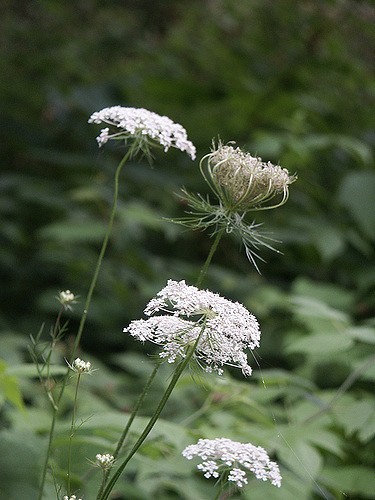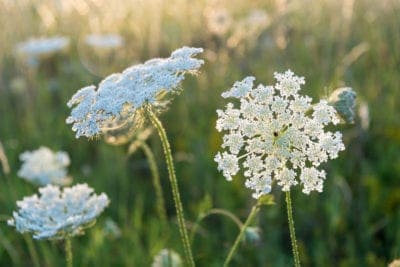Queen Anne’ Lace or Wild Carrot?

Queen Anne’s lace, also known as wild carrot, is a wildflower herb found in many parts of the US, yet it is originally from Europe. While most places now consider this plant an invasive weed, it can actually be an attractive addition to your home wildflower garden. This plant can reach heights of 1 to 4 feet high and features fern-like foliage with tall, hairy stems that hold a flattened cluster of tiny white flowers and single dark-colored floret in its center. You can find these biennials in bloom during their second year from spring to fall.
 This plant’s common name came from the legend of Queen Anne of England (1665-1714), an expert lace maker, who pricked her finger with a needle causing a single drop of blood to fall onto the lace she was sewing. Queen Anne’s lace grows from a taproot, which looks much like a carrot and is edible when young. The roots of a first year Queen Anne’s lace are often used in soups, stews and in making tea. Poison hemlock, a similar looking plant to Queen Anne’s lace, can be deadly when ingested. The best way to tell the difference between the two plants is by smell. Queen Anne’s lace smells like a carrot and features a hairy stem, while poison hemlock offers an unpleasant odor.
This plant’s common name came from the legend of Queen Anne of England (1665-1714), an expert lace maker, who pricked her finger with a needle causing a single drop of blood to fall onto the lace she was sewing. Queen Anne’s lace grows from a taproot, which looks much like a carrot and is edible when young. The roots of a first year Queen Anne’s lace are often used in soups, stews and in making tea. Poison hemlock, a similar looking plant to Queen Anne’s lace, can be deadly when ingested. The best way to tell the difference between the two plants is by smell. Queen Anne’s lace smells like a carrot and features a hairy stem, while poison hemlock offers an unpleasant odor.

It is best to plant Queen Anne’s lace somewhere with adequate space to spread. This plant is adaptable to a variety of soils and prefers sun to partial shade. To prevent the spread of this plant, deadhead the flowers before the seeds have a chance to disperse. The plant can also be controlled by digging up the entire taproot. Handling of this plant may also cause skin irritation or an allergic reaction to sensitive individuals.
Today, the delicate flowers of this plant are found in floral arrangements for special events like weddings and formal dances.
Source & Images:
https://www.gardeningknowhow.com/ornamental/flowers/queen-annes-lace/queen-annes-lace-plant.htm
